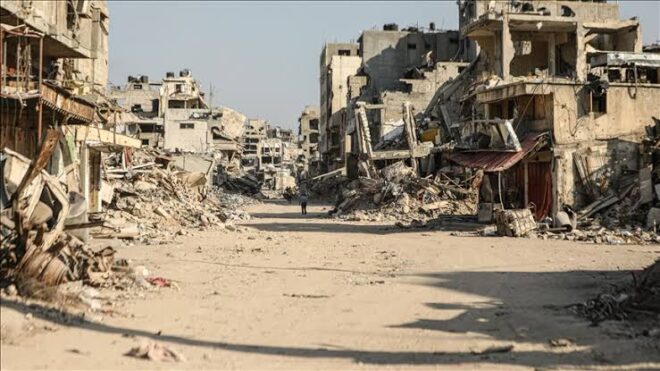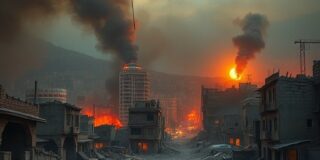
“Whoever destroys one life, it is as if he destroyed a whole world; and whoever preserves one life, it is as if he preserved a whole world”: (Mishnah Sanhedrin 4:5).
Introduction
On April 8, 2025, United Nations Secretary-General António Guterres delivered a poignant and forceful critique of Israel’s ongoing blockade of the Gaza Strip, categorising it as a violation of international law and a catalyst for what he termed the “floodgates of horror.” Speaking from U.N. headquarters in New York, Guterres emphasised the devastating consequences of over a month without humanitarian aid entering Gaza, where no food, fuel, medicine, or commercial supplies have been permitted. His remarks come in the wake of escalating violence, notably highlighted by a deadly Israeli airstrike on April 9, 2025, in the Shejaiya neighbourhood of Gaza City, which tragically resulted in the loss of at least 29 lives, including eight women and eight children, and left over 60 others injured. This analysis seeks to explore the legal basis of Guterres’ condemnation, the humanitarian toll exacted by the blockade and military strikes, and the broader geopolitical implications of the ongoing crisis, all situated within the protracted Israeli-Palestinian conflict.
The Blockade: A Humanitarian Catastrophe
The blockade imposed by Israel on Gaza has intensified in recent months, effectively isolating the region from the outside world. Guterres’ assertion that “no drop of aid” has entered Gaza for over a month underscores the severity of the humanitarian crisis. Gaza, home to approximately 2.3 million people, is one of the most densely populated areas on the planet, relying heavily on external assistance to meet its basic needs. The absence of food has driven the population toward famine, with local health officials reporting widespread malnutrition, particularly among children. The lack of fuel has crippled electricity generation, rendering hospitals, water treatment plants, and sanitation systems inoperable. The absence of medicine and surgical supplies has turned treatable injuries and illnesses into death sentences.
The humanitarian impact of the blockade was starkly illustrated by the aftermath of the April 9 airstrike in Shejaiya. Gaza’s civil defence agency reported that the strike completely levelled a residential building, killing 29 individuals and injuring dozens more. Hospitals, already strained by shortages, struggled to respond to the influx of casualties. Doctors described a healthcare system on the brink of collapse, where mass casualty incidents overwhelmed facilities that lacked essential supplies such as blood units, anaesthesia, and even basic bandages. The Israel Defence Forces (IDF) claimed the strike targeted a senior Hamas militant, though they did not disclose the individual’s name, raising serious questions about the precision and proportionality of the operation – issues that remain contentious in the ongoing conflict.
Legal Dimensions: International Law and the Blockade
U.N. Secretary-General António Guterres’ assertion on April 8, 2025, that Israel’s blockade of the Gaza Strip violates international law invokes a complex web of legal principles spanning humanitarian, human rights, and maritime law. This section delves into the specific frameworks underpinning his condemnation, the legal status of Israel’s actions, and the challenges of enforcement in the context of the Israeli-Palestinian conflict.
The Fourth Geneva Convention and Collective Punishment
At the core of the legal critique of the blockade is the Fourth Geneva Convention of 1949, which governs the treatment of civilians in times of war and occupation. Article 33 explicitly prohibits collective punishment, stating, “No protected person may be punished for an offence he or she has not personally committed.” By imposing a blanket blockade that denies Gaza’s 2.3 million residents access to food, fuel, medicine, and commercial supplies for over a month, Israel risks breaching this provision. The blockade’s indiscriminate impact – starving civilians regardless of their affiliation with Hamas – supports Guterres’ charge that it transforms Gaza into a “killing field.”
Israel’s status as an occupying power further complicates the legal landscape. Although Israel withdrew settlers and troops from Gaza in 2005, it retains control over the territory’s borders (except the Rafah crossing with Egypt), airspace, and territorial waters. The International Committee of the Red Cross (ICRC) and numerous legal scholars argue that this degree of control sustains Israel’s obligations under Article 55 of the Fourth Geneva Convention, which mandates that an occupying power ensure the provision of food and medical supplies to the population “to the fullest extent of the means available to it.” The complete cessation of aid inflows, as noted by Guterres, appears to contravene this duty, particularly given Israel’s capacity to facilitate humanitarian access.
Proportionality and Distinction in Armed Conflict
The airstrike in Shejaiya on April 9, 2025, which resulted in the deaths of 29 civilians – including eight women and eight children – highlights another critical principle of international humanitarian law: the principles of distinction and proportionality. Codified in Additional Protocol I to the Geneva Conventions (1977), Article 51 requires military operations to distinguish between combatants and civilians and to avoid attacks that cause excessive civilian harm relative to the concrete military advantage gained. The IDF’s assertion that the strike targeted a “senior Hamas militant” raises significant questions about adherence to these principles. Without disclosing the militant’s identity or the specific threat posed, it is challenging to assess whether the deaths of 16 non-combatants were proportionate. The destruction of an entire residential building, as evidenced by footage from the scene, suggests a lack of precision that may violate the duty to minimise civilian harm.
Israel counters that Hamas’ practice of embedding military assets within civilian areas complicates compliance with these rules. However, the International Court of Justice (ICJ) has emphasised that the presence of combatants does not absolve an attacking force of its obligations to take “all feasible precautions” (Article 57, Additional Protocol I). The recurring pattern of high civilian casualties in Gaza strikes – illustrated by the Shejaiya incident – has fueled calls for independent investigations, though such efforts are often hindered by geopolitical deadlock.
Maritime Blockade and the Law of the Sea
Israel’s naval blockade of Gaza, a key component of its broader strategy, also engages the United Nations Convention on the Law of the Sea (UNCLOS) and customary international law. Since 2007, Israel has restricted maritime access to a narrow fishing zone, citing security threats from Hamas smuggling operations. However, the blockade’s expansion to prevent all aid shipments – including those inspected and approved by international bodies – may exceed lawful bounds. A naval blockade is permissible under international law during an armed conflict, but it must not “starve the civilian population” or “deny them other objects essential for their survival,” as outlined in the San Remo Manual on International Law Applicable to Armed Conflicts at Sea (1994). Guterres’ report of “no food, no fuel, no medicine” entering Gaza for over a month suggests a breach of this standard, aligning with the UN’s view that the blockade has become a tool of collective deprivation rather than a targeted security measure.
Human Rights Law and the Right to Life
Beyond humanitarian law, the blockade implicates international human rights law. The Universal Declaration of Human Rights (1948) and the International Covenant on Economic, Social and Cultural Rights (ICESCR, 1966), to which Israel is a party, affirm the rights to food (Article 11, ICESCR), health (Article 12), and an adequate standard of living. The deliberate restriction of these essentials, combined with the collapse of Gaza’s healthcare system – as evidenced by hospitals’ inability to treat the wounded from Shejaiya due to shortages – may constitute a violation of the right to life under Article 6 of the International Covenant on Civil and Political Rights (ICCPR). The UN Human Rights Council has repeatedly framed Gaza’s conditions as a human rights crisis, a perspective echoed in Guterres’ description of an “endless death loop.”
Challenges of Accountability
Despite the clarity of these legal frameworks, enforcing accountability remains elusive. The UN Security Council, the primary body for addressing breaches of international law, is often paralyzed by the veto power of the United States, Israel’s staunch ally. Past resolutions condemning Israel’s actions in Gaza have been blocked, limiting the UN’s response to rhetorical rebukes like those from Guterres. The ICJ, while capable of issuing advisory opinions – as it did in 2004 regarding Israel’s separation wall – lacks binding enforcement mechanisms. The International Criminal Court (ICC) has jurisdiction over war crimes in Palestine (a state party since 2015), but Israel’s non-membership and US opposition constrain its reach.
Moreover, Israel defends its actions as lawful self-defence under Article 51 of the UN Charter, arguing that Hamas’ rocket attacks and tunnel operations justify stringent measures. This claim hinges on the blockade’s effectiveness in preventing attacks, a metric that is challenging to evaluate amid ongoing violence. Critics, however, contend that self-defence does not permit indefinite collective punishment or the disproportionate suffering documented in Gaza.
The Humanitarian Toll: A “Floodgates of Horror”
The Secretary-General’s vivid metaphor of “floodgates of horror” encapsulates the cascading effects of the blockade and military operations. The aftermath of the Shejaiya strike – captured in footage showing a flattened residential building and a resident knocked to the floor 200 meters away – illustrates the physical destruction inflicted on civilian infrastructure. Beyond the immediate loss of life, the psychological toll on survivors is profound. Children, who constitute nearly half of Gaza’s population, endure repeated trauma from bombardment, displacement, and deprivation.
Hospitals, as critical lifelines, are buckling under the pressure. The lack of fuel has forced many to rely on dwindling generator reserves, while shortages of surgical supplies mean that even minor injuries can lead to amputations or death. The absence of blood units exacerbates the crisis, with doctors forced to prioritise patients in a grim triage process. This collapse of healthcare infrastructure amplifies the blockade’s lethality, turning Gaza into what Guterres described as a “killing field.”
Economically, the cessation of commercial supplies has paralysed Gaza’s already fragile economy. Markets lie empty, unemployment soars, and families resort to bartering or scavenging for survival. The blockade’s duration – over a month as of April 8, 2025 – suggests a deliberate strategy, intensifying debates over its intent and legality.
Geopolitical Context: Israel, Hamas, and the International Community
The blockade and airstrikes occur against the backdrop of a protracted conflict between Israel and Hamas. Israel justifies its actions as a response to Hamas rocket attacks and tunnel operations targeting Israeli territory. The IDF’s claim of targeting a senior militant in Shejaiya aligns with this narrative, though the lack of specificity fuels skepticism. Hamas, for its part, has condemned the blockade as an act of aggression, rallying domestic support by framing it as collective punishment of Palestinians.
The international community remains deeply divided. Guterres’ rebuke reflects a growing frustration among UN officials and humanitarian organisations, many of whom have long criticised Israel’s policies in Gaza. However, Israel’s key allies, notably the United States, have historically supported its right to self-defense, often vetoing UN Security Council resolutions critical of its actions. This dynamic limits the UN’s ability to enforce accountability, leaving Guterres’ words as a moral rather than practical intervention.
Regional powers also shape the crisis. Egypt, which shares a border with Gaza, has maintained its own restrictions on the Rafah crossing, citing security concerns tied to Hamas’ link with Islamist groups in the Sinai Peninsula. Qatar and Turkey, meanwhile, have provided financial and diplomatic support to Gaza, though their influence is curtailed by the blockade’s physical barriers.
Implications and the Path Forward
The current crisis in Gaza, as articulated by Guterres, poses urgent questions about the sustainability of Israel’s strategy and the international community’s response. The blockade’s humanitarian toll risks radicalising a new generation of Palestinians, potentially strengthening Hamas’ position, despite Israel’s aim to weaken it. The destruction of civilian infrastructure, as seen in Shejaiya, complicates postwar recovery, perpetuating the “endless death loop” Guterres described.
A resolution requires immediate steps: lifting the blockade to allow aid inflows, establishing a ceasefire to halt airstrikes and rocket attacks, and reviving diplomatic efforts toward a two-state solution or other negotiated settlement. Yet, the political will for such measures remains elusive. Israel’s security concerns, Hamas’ militancy, and the international community’s paralysis suggest that Gaza’s plight will persist absent a significant shift in dynamics.
Conclusion
António Guterres’ condemnation of Israel’s blockade as a violation of international law and a trigger for unimaginable suffering underscores the gravity of Gaza’s humanitarian crisis as of April 10, 2025. The Shejaiya airstrike, with its devastating civilian toll, exemplifies the interplay of military action and blockade-induced vulnerability. While legal frameworks provide a basis for critique, the geopolitical realities of the Israeli-Palestinian conflict limit enforceable solutions. Gaza remains a stark reminder of the human cost of unresolved conflicts – a “killing field” where civilians bear the brunt of strategic deadlock. Addressing this horror demands not only humanitarian relief but a reckoning with the deeper structural issues fueling the violence.
As we reflect on this ongoing crisis, it is imperative that we advocate for immediate action and a renewed commitment to peace, justice, and the protection of human rights for all individuals in the region.



